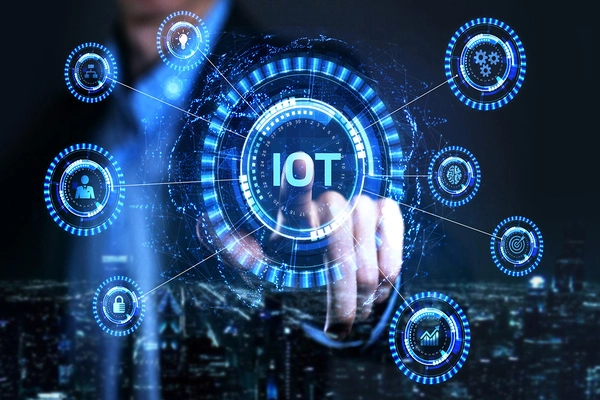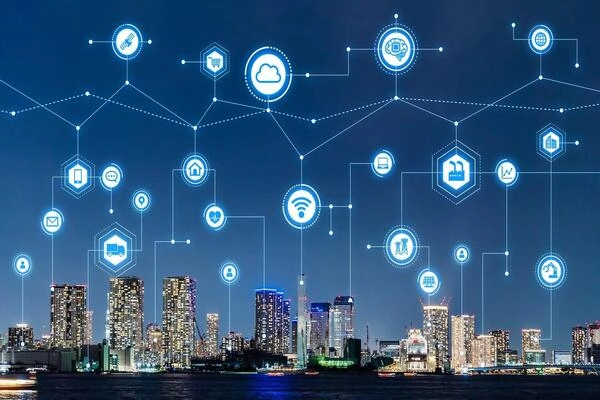IoT applications (Internet of Things) are becoming an essential trend in the digital era. By enabling smart devices to connect and exchange data, IoT provides innovative solutions in manufacturing, healthcare, education, and daily life, helping people manage, monitor, and make decisions more efficiently.
What is IoT? Its role in modern life
IoT (Internet of Things) is a network of physical devices connected to the Internet, capable of collecting, exchanging, and analyzing data in real time. From smartphones and TVs to sensors and industrial machines, all devices can communicate through IoT platforms, allowing humans to control, optimize, and automate processes across various fields.

IoT applications are not limited to industrial or high-tech sectors—they also penetrate everyday life. From voice-controlled lighting to automated irrigation systems in agriculture, IoT contributes to creating a more convenient, safe, and efficient world. In the digital age, IoT serves as a “smart infrastructure” that drives digital transformation, creating breakthroughs for organizations, businesses, and society as a whole.
IoT Applications in Various Sectors
The rapid advancement of sensor technology, cloud computing, and 5G networks has significantly expanded the practical applications of IoT across multiple sectors. The following examples illustrate how IoT is transforming the way we live, work, and manage everyday systems.
Smart Homes and Offices
In smart homes, IoT applications provide convenience and optimize energy efficiency. Devices such as lights, air conditioners, cameras, and door locks can be controlled remotely via smartphones. For instance, temperature sensors can automatically adjust the air conditioning when a room gets too warm or turn off devices when no one is present.

In office environments, IoT supports energy management, security monitoring, and workspace optimization. Automated lighting systems, smart meeting room management, and motion sensors help improve work efficiency while reducing operational costs.
Smart Agriculture
Agriculture is one of the key sectors benefiting from IoT applications. Moisture, temperature, and light sensors allow farmers to monitor environmental conditions and adjust water and fertilizer levels appropriately. Automated irrigation systems, based on weather and soil moisture data, help conserve water and improve crop yields. Additionally, IoT enables livestock health monitoring and early disease detection, reducing risks and production costs.
Manufacturing Industry
In manufacturing, IoT applications enable the concept of “Smart Factories.” Connected sensors and devices collect data from production lines, allowing companies to monitor machinery status in real time. This enables early fault detection, optimized maintenance schedules, and minimized downtime. Moreover, IoT data analysis helps improve productivity, reduce energy consumption, and enhance product quality.
IoT Applications in Logistics and Transportation
Practical IoT applications in logistics allow goods to be tracked from storage to delivery. GPS sensors, RFID tags, and temperature monitoring devices ensure that items, especially medical products, fresh food, or perishable goods, are transported under proper conditions.

Thanks to IoT, companies can optimize delivery routes, reduce fuel costs, and improve delivery times. Consumers can also track their orders transparently and accurately.
IoT Applications in Maintenance and Equipment Monitoring
In many industries, IoT applications enable continuous monitoring of equipment performance. Vibration, temperature, and pressure sensors detect anomalies before issues occur. This allows businesses to shift from scheduled maintenance to predictive maintenance, reducing costs and preventing unexpected breakdowns. As a result, operational productivity increases, while ensuring the safety of workers and machinery.
IoT Applications in Education and Training
In education, practical IoT applications introduce innovative and highly interactive teaching methods. IoT devices help manage smart classrooms, monitor student participation, and assist teachers in tracking learning progress.
Additionally, IoT contributes to creating a safe learning environment through access control systems, cameras, and environmental sensors. In vocational training, IoT devices simulate real production processes, providing students with hands-on, practical, and immersive learning experiences.
IoT Applications in Smart Transportation
IoT applications in transportation are playing a key role in building smart cities. Traffic sensors, cameras, and connected signal control systems help analyze vehicle flow, coordinate traffic, and reduce congestion.

Smart vehicles use IoT data to enhance driving safety, provide collision warnings, or automatically brake when obstacles are detected. Additionally, integrating data from public transportation systems helps optimize routes, saving both time and fuel for commuters.
IoT Applications in Building Management
In construction and real estate management, practical IoT applications enable monitoring and control of building systems such as electricity, water, elevators, lighting, and security. IoT sensors can automatically adjust temperature, detect water leaks, or provide timely fire alerts. This not only ensures safety but also improves energy efficiency and enhances the living experience. Smart buildings are becoming an essential trend in modern urban development.
Risks and Challenges of Expanding IoT Applications
While IoT offers significant benefits, large-scale implementation also faces several risks and challenges. First, cybersecurity is a top concern. With billions of devices connected to the Internet, the risk of attacks, data leaks, or unauthorized access increases. Therefore, data encryption, software updates, and system security measures are essential.

Second, compatibility between different devices and platforms remains limited. IoT connection standards are not fully unified, making system integration complex. Finally, investment and operational costs can be a barrier for small businesses or rural areas. However, as technology advances and costs decrease, IoT will become increasingly accessible in the near future.
IoT applications are revolutionizing how people live, work, and connect with the world. From smart homes, agriculture, and manufacturing to education and transportation, IoT enables automation, optimization, and greater efficiency. Despite challenges in security and cost, its potential is undeniable, paving the way for a fully digitalized era for businesses and society.
